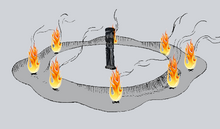Peryn Skete

The Peryn isle in the period of spring flooding, 2009. Historically, it looks like that. Lake Ilmen is on the horizon
|
|
| Location | Veliky Novgorod, Russia |
|---|---|
| Coordinates | 58°28′22″N 31°16′25″E / 58.47278°N 31.27361°ECoordinates: 58°28′22″N 31°16′25″E / 58.47278°N 31.27361°E |
 |
|
| History | |
|---|---|
| Founded | 980 A.D. (the last shrine) |
| Abandoned | 989 A.D. |
| Cultures | Slavic paganism |
| Site notes | |
| Excavation dates | 1951, 1952 |
| Archaeologists | , Artemi Artsyhovky |
| The Peryn Skete | |
|---|---|
 |
|
| Basic information | |
| Region | Orthodox Christianity |
| Ecclesiastical or organizational status | the skete in the name of the Nativity of Our Lady of the Yuriev Monastery |
| Status | active |
| Website | http://georg.orthodoxy.ru/skit.htm (in Russian) |
| Architectural description | |
| Architect(s) | I. Sokolov (the cells) |
| Architectural style | cross-in-square (the church), eclecticism (the cells) |
| Groundbreaking | 11th century (the first church of wood) |
| Completed | 1840s (the cells) |
| Official name: The ensemble of the Peryn Skete | |
| Type | Cultural |
| Criteria | ii, iv, vi |
| Designated | 1992 |
| Reference no. | 604 |
| Region | Europe and North America |
| The Peryn Chapel | |
|---|---|
 |
|
| Basic information | |
| Region | Orthodox Christianity |
| Status | active |
| Architectural description | |
| Architectural style | cross-in-square |
| Completed | presumably 1224 |
Peryn (Russian: Перы́нь, IPA: [pʲɪˈrɨn]) is a peninsula near Veliky Novgorod (Russia), noted for its medieval pagan shrine complex, and for its later well-preserved monastery.
The Peryn peninsula is at the confluence of Lake Ilmen and the River Volhov, 6 km (3.7 mi) south of the city of Veliky Novgorod. In the Dark Ages, the city was developed not far from Peryn, at Ruerikovo Gorodische also known as Holmgård, but its business and social activities were later moved to form today's city centre. The area south of Novgorod, including Peryn, is therefore considered part of the historic surroundings of Veliky Novgorod.
Historically, Peryn was an islet formed by the River Volkhov and two small rivers called and . It could only be reached by boat. The conditions changed significantly after a dam was constructed in the 1960s to provide access for vehicles. After the 1960s Peryn looked like a peninsula but now it looks more like a hill which only becomes a peninsula when floods arrive in the spring.
Novgorod was a centre of Slavic paganism in the Dark Ages. Accordingly, the Peryn island appears to have played a role similar to that of the Vatican Hill in the sense of its functions in the medieval Novgrorod and its later history. The name "Peryn" is related to the Slavic god Perun, whose shrine was there in the 10th century. The results of archaeological excavations under the guidance of described in his survey of Peryn, suggest that Peryn was a sacred place from ancient times. It is likely that the area has seen several pagan shrines, replacing one with another over time. The best known is the heathen shrine, established there in 980. Early Slavs used to set up anthropomorphic statues of wood, picturing their gods to serve the cult, and in 980 in Peryn it was carried out this way:
...
Wikipedia
